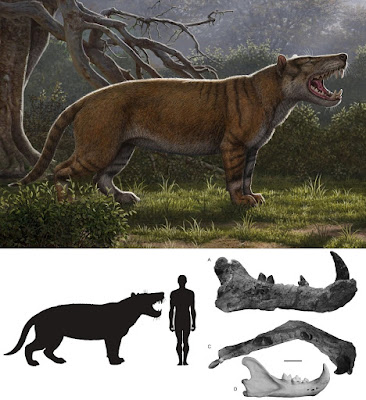 |
Simbakubwa kutokaafrika
Borths & Stevens, 2019
Illustration: Mauricio Antón
|
ABSTRACT
Hyainailourine hyaenodonts are among the largest terrestrial carnivorous mammals known. The clade is widely dispersed, found in Eurasia, North America, and Afro-Arabia in the Paleogene and early Neogene. In this study, we describe dental and postcranial material from Simbakubwa kutokaafrika, gen. et sp. nov., the most complete hyainailourine known from sub-Saharan Africa. The material is from a relatively young adult from the early Miocene locality of Meswa Bridge, Kenya. Simbakubwa differs from Hyainailouros in exhibiting lingually oriented molar protocones, gracile metastyles, and buccolingually compressed, shearing canines. Like other large Miocene hyainailourines, Simbakubwa has deep carnassial notches on the molars and tall paracones fused to shorter metacones forming single piercing cusps. A Bayesian phylogenetic analysis recovers Simbakubwa as the sister taxon of a clade of large-bodied Miocene hyainailourines that includes Hyainailouros and Megistotherium. Bayesian ancestral state reconstruction supports an Afro-Arabian origin for Hyainailourinae with subsequent dispersal to Eurasia during the early Miocene. Regression analysis based on carnassial size is applied to Simbakubwa and closely related hyainailourines, recovering a body mass up to 1,500 kg for the new taxon. The evolution and extinction of Hyainailourinae offers important insights for interpreting ecological transitions from Paleogene to Neogene faunas in Afro-Arabia and Eurasia.
SYSTEMATIC PALEONTOLOGY
MAMMALIA Linnaeus, 1758
EUTHERIA Huxley, 1880
HYAENODONTA Van Valen, 1967, sensu Solé et al., 2015
HYAINAILOUROIDEA Pilgrim, 1932, sensu Borths et al., 2016
HYAINAILOURINAE Pilgrim, 1932, sensu Solé et al., 2015
SIMBAKUBWA KUTOKAAFRIKA, gen. et sp. nov.
Etymology— Simbakubwa, from Swahili ‘simba’ meaning ‘lion’ and ‘kubwa’ meaning ‘big’; kutokaafrika, from Swahili meaning ‘from Africa.’
Matthew R. Borths and Nancy J. Stevens. 2019. Simbakubwa kutokaafrika, gen. et sp. nov. (Hyainailourinae, Hyaenodonta, ‘Creodonta,’ Mammalia), A Gigantic Carnivore from the earliest Miocene of Kenya. Journal of Vertebrate Paleontology. DOI: 10.1080/02724634.2019.1570222
Fossils found in museum drawer in Kenya belong to gigantic carnivore eurekalert.org/e/959Z via @EurekAlert
PLAIN LANGUAGE SUMMARY
Hyainailourines were some of the largest mammalian carnivores to ever walk the earth. In this study we describe a new hyainailourine from Kenya, Simbakubwa kutokaafrika. Simbakubwa kutokaafrika, whose name means “Big lion from Africa” in Swahili, was the size of a small rhinoceros and lived about 23 million years ago. The hyainailourine lineage is part of Hyaenodonta, a diverse group of meat-eating mammals unrelated to hyenas that lived in Eurasia, North America, and Africa for the first three-quarters of the Age of Mammals. We estimated the size of Simbakubwa using beautifully preserved teeth that were discovered at Meswa Bridge, an important fossil site in Kenya that also preserves evidence of our early ape relatives. Most of Simbakubwa’s close relatives are known from worn and scrappy fossils. Simbakubwa makes it easier to interpret fragmentary hyainailourine material from Eurasia and Africa. We used the new specimens to place Simbakubwa in the hyaenodont family tree. Based on our analysis, giant hyainailourines originated in Africa about 30 million years ago and they moved into northern ecosystems multiple times before going extinct about ten million years ago. The Miocene, the epoch when giant hyainailourines reigned, was a time of massive tectonic and ecological change as Africa collided with Eurasia, lineages encountered each by crossing the newly formed land bridge, grasslands expanded, and the evolving East African Rift changed climate patterns. The discovery of Simbakubwa offers new insights into how carnivorous mammals adapted to these dramatic changes and gave rise to the modern African ecosystem.







